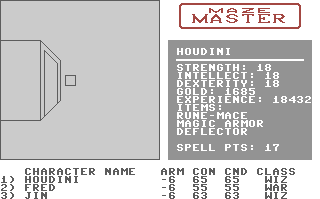 |
| Eat it, you basement-dwelling, spandex-wearing, ant-headed freak! |
It all ends on level 5. You can't magically teleport there, but you can teleport directly to the stairs on level 4 that lead down to it, and the balrog's lair is just a few secret doors away. I found him almost immediately, and he wiped the floor with us. There's only one of him, but he strikes first, always hits, and instantly kills whoever he hits.
But let's back up for a second. Each of the upper floors has a clue hidden somewhere, which I have shown in the maps but not mentioned yet. Said clues are:
- I HAVE LAID 3 CLUES TO BRING YOU TO ME...
- I AM DESTINY PERSONIFIED
- TOWARD THE NE WARE THE STOP ELSE MAGIC TRIES TO MAKE YOU DROP
- MY NAME IS IN THE LOWER 4 MAPS
The walls of maps 2 through 4 contain one identifiable letter each. F-A-T. I don't think it takes a riddle master to figure out what comes next.
To beat the balrog, I assembled a team of three Freds. Magic is good for zipping around and eliminating crowds, but the balrog fights alone. I need concentrated damage, I know protection magic won't help, and I can get three good warriors by dismissing my wizards and restoring Fred's character code twice.
This means no teleportation, so we walk to level 5. No big deal. I have maps, and the path is clear. There's just one mandatory fight along the way, a square of infinite monsters on level 4, but each Fred can hit up to four times now, and you can pass through the square after winning the fight - it just doesn't "clear" for the future the way others do.
On reaching the hidden lair, we are presented with a riddle to enter.
 |
| FATE. You are FATE. |
We enter and fight to the last Fred.
 |
| After winning you are trapped in a 2x2 room with no way out. |
And, well, that's it. I didn't even need to explore level 5 or train further. I just had to slightly abuse a questionable character management system.
Maze Master defeated CRPG Addict, who wrote in 2014 that it would have been "fun" to be the only person online to beat the game, and later did with hacked supercharacters, save states, and spoilers. I may now be the only person online to beat it without doing any of that, and it wasn't that much fun.
GAB rating: Below average. Borderline bad, really. There's nothing dysfunctional about Maze Master, but it is emphatically not fun or interesting to play. Wizardry was good in spite of its bare-bones look and feel because of its deceptively deep combat engine, but there's no strategic depth to this imitator whatsoever, nothing of interest at all to find in these mazes, and once you gain enough power to do any serious dungeon exploration the combat becomes and remains pathetically easy, which is admittedly better than the more common alternative.
I found some spoilers regarding the magic items, and all of them except the Ring of Accuracy are useless.
- Staff of Light - Useless. Its just a permanent Cat's Eye spell, which should be no problem for you to cast as needed long before you can afford this staff's $5000 pricetag.
- Ring of Accuracy - A +25% chance to hit. Mainly useful for the fighter, but not a bad effect. The Accuracy spell does the same thing, but has to be cast during combat, so having this as a permanent buff is convenient.
- Amulet of Healing - Nearly useless. Heals one HP every ten seconds. Who wants to wait several minutes between combats to heal up? Especially since wandering monsters will certainly interrupt your rest. Just teleport to the surface to heal.
- Hawk Blazon - Useless and outrageously expensive. It sets your AC to -10, which is as low as it can get. You'd have the same effect for less money by buying the best armor and shield and casting Shadow Shield which lasts the entire trip.
Last call for inclusion in Cranford's follow up, Shadow Snare The Bard's Tale! The guild roster of Skara Brae's chapter includes so far Scribe as a magician, P-Tux as a hobbit rogue, and Viila as a to-be-determined class with a death wish. To be clear, you won't be actively participating; you'll just be represented ingame, at least for as long as your pragmatic and pitiless patrol captain deems your person useful.


























